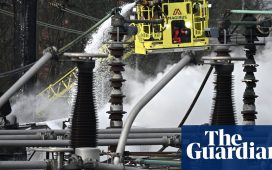British electricity prices were double those paid in France and Spain in the spring, with the steel industry saying the disadvantage could hinder UK efforts to switch to greener technology.
UK companies paid nearly £66 per megawatt hour (MWh) for wholesale electricity in the second quarter of 2024, well over double the French and Spanish equivalents in the same period, according to analysis of industry data by the lobby group UK Steel.
The gap between UK prices and those of Spain and France has widened to its largest since at least 2015, when the group started tracking price movements. During that time the UK has been consistently more expensive, except during the energy crisis sparked in 2022 by Russia’s invasion of Ukraine, when prices were extremely volatile.
The growing divergence between the UK and rivals’ electricity costs represents a big challenge for an expected Labour government, which has voiced full-throated support for the steel industry in switching to electric technology and away from polluting coal. It has pledged £3bn in subsidies.
Within hours of polls in the UK general election closing on Thursday evening, Tata Steel will tap the last iron from one of its two blast furnaces at Port Talbot in south Wales after a closure process lasting several days.
The Indian-owned company is planning to close its second blast furnace and the rest of its steel-making process in September before building a much cleaner electric arc furnace. The plans, which have been at the centre of a row with unions, involve as many as 2,800 job losses.
Jonathan Reynolds, who will be business secretary if Labour wins the election, is expected to meet Tata Steel executives as soon as Monday to discuss government support for the company. The Conservative government agreed £500m in subsidies, but unions are hopeful that Labour will push for a deal that protects more jobs.
Tata executives have said they will consider the business case for further investments which could save more jobs, although Labour has not said what it plans for the remainder of the promised £3bn.
Relatively high energy prices in the UK, however, act as a brake on investment by heavy industry. Much of the European investment in steel innovation – such as making direct reduced iron using hydrogen – has been directed to Sweden, where there is abundant cheap hydropower.
after newsletter promotion
The average electricity prices for France and Spain were £26.68 and £27.89 respectively in the second quarter of 2024, according to UK Steel. The figures refer to wholesale prices only, and do not include policy levies and network charges. French costs have been helped by the return to service of several nuclear power plants, while Spain has used abundant solar power.
Executives in energy-intensive industries ranging from steel and glass to ceramics and chemicals have long complained that UK electricity costs leave them at a significant disadvantage relative to their European rivals. UK plants and factories often compete directly with EU counterparts for investments.
UK Steel’s energy and climate change policy manager, Frank Aaskov, said: “The steel industry is the foundation of the UK’s manufacturing and economic strengths. We must not lose sight of how important electricity costs are in the move to green steel as we fully switch to electric arc furnace technology to secure steel for our nation.
“The UK steel industry cannot continue to face electricity prices that are more than double what our main European competitors benefit from. For the UK steel industry to prosper and deliver on its decarbonisation targets, a new government must deliver the lowest electricity prices in Europe.”
The government has taken some action to reduce industrial energy costs, including the so-called supercharger policy which cuts levies funding renewable energy for some big electricity users. Room for manoeuvre is limited, however, because UK electricity prices are closely related to prices for methane burned in power stations.










